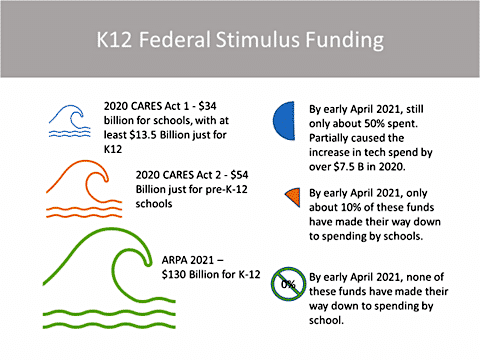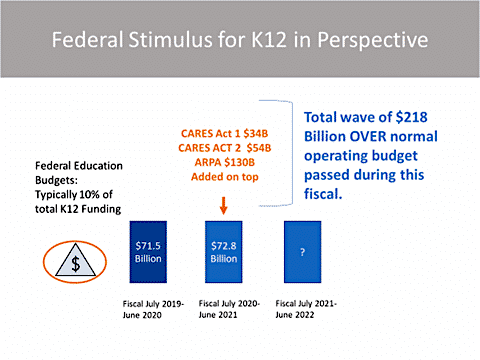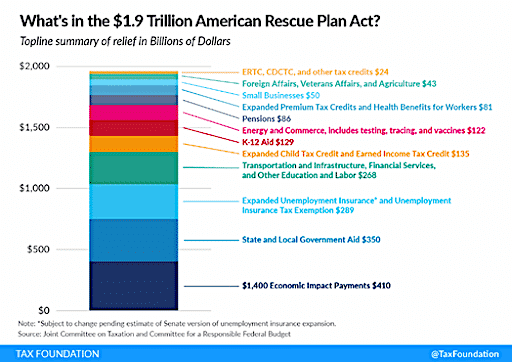The three Federal stimulus bills already passed are seriously spiking the available monies for schools going into the rest of 2021 and indefinitely into the future. It depends on how fast and how much they can spend all of it. In the original big monies for ARRA in 2008, the spending took nearly five years to spend out and the Feds finished it off by overtly hounding the States to get busy and spend a few billion that was left as late as 2012.
Superintendents have already reported privately to Learning Counsel that they “don’t know how they will spend it all.” It’s that much money. In addition, a “funding cliff” later is not expected to any degree within the next 2 years, possibly as long as five because of other portions of the stimulus Acts.
The first wave in 2020, CARES Act 1, gave approximately an additional $13.5B to schools. By the beginning of April, only about 50 percent of it was spent.
CARES Act 2 gave an additional $54 Billion just for K12 in December 2020 for K12 schools. By early April, only about 10 percent of these funds have made their way down to spending by schools.
The American Rescue Plan Act provided an additional $130 Billion for K12. By early April, none of these funds have made their way to schools.


With an estimated 3.6 Million teachers and administrators in K12, the stimulus amounts to an average of $60,555 per employee or $3,963 per student additional spending money. That’s $3,963 per student over the regular annual spend average per student of $14,439. That’s just shy of a 28 percent spike with very little in the way of expected serious cuts in the subsequent 2-5 years because of the pandemic from March of 2020 through the end of 2021.
Usually, the Federal portion of all monies in K12 is about 10 percent. These large waves were spent to support presumed losses to local and State tax revenues since they are typically 90 percent of the spend on K12. Total losses, though, are now expected to be averaging only around 5% less for 2020, 2021 and 2022 for States and local governments. Some States are reporting almost no losses. The spend overall was much higher than coverage for that 5 percent loss nationally, at $6 Trillion in stimulus acts in addition to the $4.829 trillion of normal fiscal spend, an increase of nearly 225 percent, more than double the federal budget.
What’s significant to understand about what this all means is that the losses to States have been covered through the numerous Acts, so much so that coming out of the pandemic, we will see much of the pensions and debt for the States wiped out. This will result in a much lower “funding cliff” for schools than there might have been once all the stimulus monies are spent because the debt and pension service will be much lower.
This graphic shows how the ARPA, at least, supported States’ budgets and pensions.
 Source: https://taxfoundation.org/american-rescue-plan-covid-relief/
Source: https://taxfoundation.org/american-rescue-plan-covid-relief/
- edCircuit – LeiLani Cauthen Articles
- NPR – The Latest Stimulus Package Includes $130 Billion For K-12 Education


